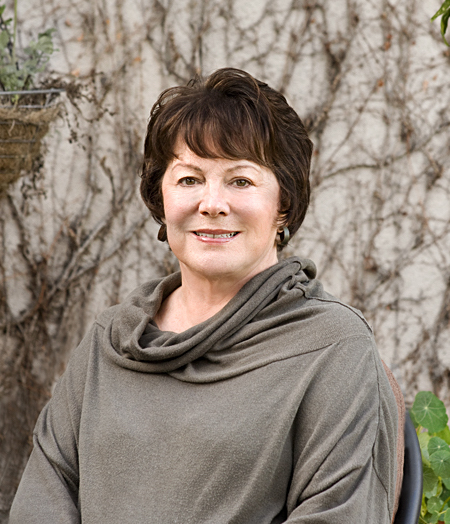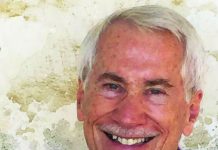Protecting Our Tree City

By Jean Hastings Ardell
There I was, perched on a barstool at one of my favorite cafés, enjoying the view across Coast Highway towards the ocean—one of the abiding pleasures of living in Laguna—when the café owner stopped by to chat. He squinted at the view and commented that it sure would be nice to cut back that tree across the street. He had a point. Smack in the midst of the ocean view was a mature tree, its branches thick with greenery.
A few days later at the same café, I Iearned from two people who are passionate aficionados of our flora, Laguna resident Chris Reed and Councilman George Weiss, that this particular tree is known as the New Zealand Christmas tree. “Pohutukawa in Maori,” explained Reed. In their opinion, this tree definitely did not need to be “cut back.” This inspired a commentary by Reed and Weiss against the practice of “poodling,“ pompomming,” and “topping” the trees in town, which “represents a lack of understanding of proper tree maintenance.” As Laguna’s arboreal cover has matured, more and more trees are being disfigured in this way, Weiss and Reed pointed out, “it’s driven by budgetary considerations,” Weiss said. “There are different levels of tree trimming expertise and the City hasn’t gone for the best level of tree maintenance. It takes more work and time to lace out a tree.” Weiss added, “A good tree, laced out, can improve the view.”
Confession here: As the Indy’s Left of Center columnist, I’ve been called many things. Hey, it goes with the territory, so no offense taken. And while I consider it inaccurate to label me a radical or a socialist—I’m actually a recovering former liberal Republican, I am a long-time unabashed tree hugger, with heart-felt opinions about these noble creations. So I agree about the importance of proper pruning—lacing out rather than hacking.
But my concerns about the care of our trees goes beyond aesthetics. It has to do within the Downtown Action Plan, proposed to revitalize the urban landscape downtown. The plan includes widening the sidewalks along Forest Avenue and moving or removing all of the existing trees. Weiss considers the project “over the top,” pointing out that the consultant proposed the purchase of mesh boxes to encourage the trees to send their roots downward rather than sidewise, which can upend sidewalks. “The boxes cost eight to twelve thousand dollars each,” he said, “and are probably not needed, as downtown is in an alluvial flood plain.”
Many in town resisted the mass removal of the trees and the idea was shelved, though it still exists. The good news is that Laguna now has its own arborist on staff, Matthew Barker. I cannot fathom why it took so long for a town designated a Tree City to hire one, but I’m glad he’s onboard. On April 26 he spoke knowledgeably and enthusiastically about his work on Zoom to Village Laguna, and in a later email exchange shared his perspective. Barker says he is pleased to be among us, given that the “frigid cold winters of the Northeast are a thing of the past,” and finds managing Palm trees, “a welcomed change of pace.” Barker noted that before he became an arborist, he “was a full-time tree climber [sounds like another tree-hugger to me] … my absolute favorite tree to climb was the American sycamore (Platanus occidentalis). I was surprised and happy to find that a closely related variety the native California sycamore (Platanus racemosa) thrives in Laguna Beach if planted in the right locations.”
Barker explained that he’s “responsible for the inspection and maintenance of the nearly 3,000 trees located within public parks, City-owned property, and the public right of way.”
That said, he also wants to reach out to Laguna residents to offer his expertise. He cites two keys to successful tree care: selecting the right species for a particular spot and avoiding the “pruning practice of topping [which] can also have a negative impact on tree health.” Matthew Barker, meet George Weiss and Chris Reed. They speak the same language. Reed and Weiss had pointed out that the California pepper tree is actually from Peru nor is the Monterey pine native to California. Barker says, “Hollyleaf cherry (Prunus ilicifolia) [an ornamental tree] suitable for sites that don’t have a lot of available crown space and Catalina ironwood (Lyonothamnus floribundus) … a medium-sized shade tree … are two great trees that are both drought tolerant and native to California.”
Maybe it’s unsurprising that in our contentious moment in time and place even trees can provoke disparate perspectives. Barker stated that he has “a cooperative and collaborative relationship with the Fire Department because urban forest management intersects directly with the science of fire prevention.” That relationship will be front and center, given the Fire Marshall’s recent notice that two trees, a pine and a palm, at 2875 Laguna Canyon Rd. pose a fire hazard and should be removed. That sparked a spirited resistance that raised enough questions for a whole other column. Tree City has a resident arborist now, and he’s going to need the community’s support, insights, and encouragement to navigate the varying perspectives on our urban forest.
Jean is a Laguna Beach resident and member of the Third Street Writers.




